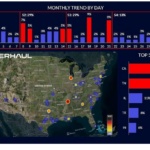A recent survey conducted by a prominent trucking organization revealed that smaller companies tend to employ a higher percentage of women drivers. This is one of the key insights from the Women In Trucking Association’s newly released 2024-25 WIT Index.
In announcing its findings the WIT said, “It has been a common assumption for years that the size of companies with for-hire or private fleets have a correlation to the percentage of professional truck drivers who are women. For the first time, the 2024-25 WIT Index reported percentage of professional truck drivers who are women based upon company workforce size.”
This year’s WIT Index shows the following:
- Micro and small companies with fewer than 500 employees report that 12.5% of their CDL-holding professional drivers are women.
- Medium and large companies with 500 to 4,999 employees report that women make up around 10.5% of their CDL-holding driver workforce.
- Major enterprises with over 5,000 employees report that about 7% of their CDL-holding truck drivers are women.
A statement from the WIT said “It’s important to note that these percentages reflect professional truck drivers who hold CDLs and are driving medium- to heavy-duty commercial trucks, not last-mile or delivery vans or other vehicles that are not heavy-duty trucks.”
The 2024-25 WIT Index survey also highlighted a notable presence of women in key leadership roles within the trucking industry. Key findings include:
- About 28% of C-suite and executive positions are held by women.
- 34.5% of supervisory leadership roles are filled by women.
- 29.5% of board members are women.
The survey also revealed significant representation of women in specific functions:
- 74.5% in human resources and talent management.
- 38.5% in dispatcher roles.
- 38.5% in safety roles.
However, only 4% of truck diesel technicians are women.
WIT conducted the survey from August 2023 to April 2024, gathering data from organizations of all sizes in the transportation industry. Respondents were asked to report demographics, the status of their diversity and inclusion policies, and the percentage of women in various roles within their companies.





